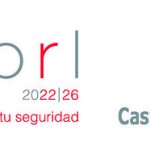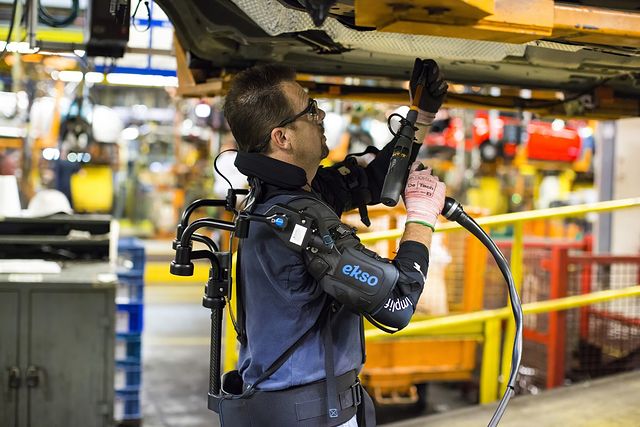



On the occasion of the European Week for Safety and Health at Work, various technical sessions have been scheduled in Castilla-La Mancha between October 21 and 25 in all provinces, with the aim of involving companies and workers in creating safer work environments. These activities will address fundamental aspects such as the use of exoskeletons, digital disconnection and the impact of technological transformation on the prevention of occupational risks.
The technological revolution has transformed all aspects of our society, including the world of work. Technological tools (robots, smartphones, advanced software…) offer us great opportunities to improve the efficiency, flexibility and productivity of companies, but they also bring with them new challenges linked to safety and health at work.
According to the EU-OSHA European Survey on New and Emerging Risks (ESENER), more than 94% of companies in the European Union have integrated some form of digital technology into their daily operations. However, despite the widespread impact of digitalisation, less than 24% of workplaces in the EU have formally discussed the risks associated with these technologies for the safety and health of their employees, evidencing a significant gap between the implementation of technology and the possible occupational risks of this transformation.
Some of the risks associated with the use of digital technologies at work are:
- Visual fatigue and musculoskeletal disorders, which mainly affect those who work long hours in front of computers or mobile devices.
- Psychosocial risks, such as increased work stress due to constant connectivity or dependence on digital devices.
- Technological fatigue, where excessive use of electronic devices and constant multitasking negatively affect the mental and physical well-being of working people.
Given the changes brought about by digitalization, the prevention of occupational risks must be adapted, first identifying the risks and developing preventive strategies that minimize their impact on the health of employees and improve work environments.


Worker.
Conferences for the European Week for Safety and Health at Work at different points of CLM
The European Week for Safety and Health at Work, organized by the European Agency for Safety and Health at Work (EU-OSHA), is an annual event held in October within the framework of the “Jobs” campaign. healthy.” This initiative, which in the period 2023-2025 focuses on the challenges and opportunities posed by digitalization in the workplace, aims to ensure that new technologies, such as artificial intelligence and robotics, are used safely.
In Castilla-La Mancha, the Ministry of Economy, Business and Employment, in collaboration with AMAT, the Association of mutual societies collaborating with Social Security, has organized various free technical sessions between October 21 and 25 in the provinces of the region, with the purpose of involving companies and workers in the creation of safer work environments.
These sessions represent an opportunity for companies and workers in the region with the aim of obtaining updated information on risks and occupational risk prevention practices, especially those linked to digital technologies.
- Monday, October 21, 11:30 a.m. Royal City. Digitization to visualize forced work postures. Official College of Industrial Engineers of Ciudad Real (C/ Conde de la Cañada, 1 – Ciudad Real).
- Tuesday, October 22. 10:00 a.m. Toledo. Health promotion in the digital age. School of Regional Administration (C/ Río Cabriel, s/n – Toledo).
- Wednesday, October 23. 10:30 a.m. Basin. Exoskeletons at work and collaborative robots. JCCM Provincial Delegation – Iberia Building (C/ Cardenal Gil de Albornoz, 1 – Cuenca).
- Thursday, October 24. 12:00h. Guadalajara. The technological transformation in the Prevention of Occupational Risks. Provincial Delegation of Economy, Business and Employment (C/ Regino Pradillo, 3 – Guadalajara).
- Friday, October 25. 10:30 a.m. Albacete. Management of the right to digital disconnection. Provincial Delegation of Economy, Business and Employment (C/ Alarcón, 2 – Albacete).
Participation in the conferences may be in person, after registering in the registration form for the corresponding conference, through the website https://segurolaboral.castillalamancha.es/agenda/calendario-de-jornadas-semana-europea -safety-and-health-at-work-safe-jobs-and
Likewise, the sessions will be broadcast live on streamingthrough the TEAMS application, in the links available on the aforementioned website.


Worker.
The European Week for Safety and Health at Work, in depth
The European Week for Safety and Health at Work is celebrated annually in October, coinciding with week 43 of the calendar. Organized by the European Agency for Safety and Health at Work (EU-OSHA) together with its partners, this week constitutes a pillar of the “Healthy Workplaces” campaign, whose main objective is to encourage dialogue and action to ensure that the The use of these tools in work environments is carried out in a safe and responsible manner.
In this event, activities such as conferences, exhibitions, competitions and training sessions are carried out, all aimed at promoting active management of safety and health in the workplace.
The campaign theme for the period 2023-2025 focuses on the challenges and opportunities that digitalization poses for occupational health and safety (OSH). The rapid integration of digital technologies into the work environment, such as artificial intelligence and robotics, offers significant advantages in reducing hazardous tasks and improving the well-being of workers. However, it also poses risks such as increased work pressure, loss of autonomy and social isolation, aspects that must be managed appropriately.
Surveys carried out by EU-OSHA reflect that the adoption of digital technologies can impact both positively and negatively on OSH. While 19.2% of workers use digital tools to control factors such as noise or hazardous substances, others face challenges from constant monitoring or intensifying the pace of work. Given this, the campaign promotes an approach based on prevention, promoting digital literacy and consultation of working people to ensure that the benefits of digitalization are not overshadowed by its risks.


Worker wearing an exoskeleton
The CLM Strategic Agreement for the Prevention of Occupational Risks, 2022-2026
To achieve this objective, the involvement of public administrations and social agents is essential.
Thus, the Strategic Agreement for the Prevention of Occupational Risks of Castilla-La Mancha, 2022-2026, promoted by the Ministry of Economy, Business and Employment of the Community Board of Castilla-La Mancha, has as one of its priority objectives to raise awareness among society about the importance of occupational health and safety as a determinant of quality of life.
Among the central axes of this agreement are the dissemination and promotion of preventive culture through various actions such as campaigns, conferences and other initiatives aimed at both companies and workers, seeking to involve the entire society in the creation of safer work environments. insurance, with special attention to the changes that digital technologies are generating in the workplace.
In this way, the Community Board of Castilla-La Mancha has joined the “Healthy Jobs” 2023-2025 campaign, promoted by the European Agency for Safety and Health at Work (EU-OSHA), which focuses on emerging risks in occupational health and safety derived from digital technologies.
The culture of prevention is essential to achieve work spaces where occupational health and safety reign, also having an impact on the quality of life of workers and the competitiveness of companies. It is in our hands that the integration of digital technologies in the world of work is carried out in a safe and healthy way for everyone.


